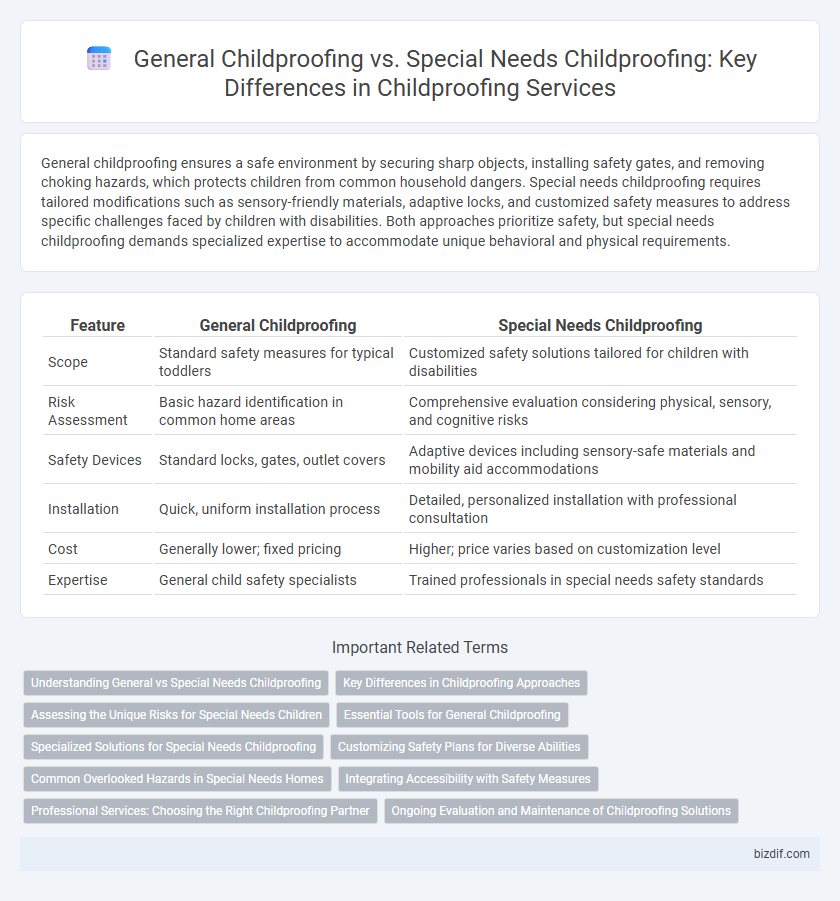General childproofing ensures a safe environment by securing sharp objects, installing safety gates, and removing choking hazards, which protects children from common household dangers. Special needs childproofing requires tailored modifications such as sensory-friendly materials, adaptive locks, and customized safety measures to address specific challenges faced by children with disabilities. Both approaches prioritize safety, but special needs childproofing demands specialized expertise to accommodate unique behavioral and physical requirements.
Table of Comparison
| Feature | General Childproofing | Special Needs Childproofing |
|---|---|---|
| Scope | Standard safety measures for typical toddlers | Customized safety solutions tailored for children with disabilities |
| Risk Assessment | Basic hazard identification in common home areas | Comprehensive evaluation considering physical, sensory, and cognitive risks |
| Safety Devices | Standard locks, gates, outlet covers | Adaptive devices including sensory-safe materials and mobility aid accommodations |
| Installation | Quick, uniform installation process | Detailed, personalized installation with professional consultation |
| Cost | Generally lower; fixed pricing | Higher; price varies based on customization level |
| Expertise | General child safety specialists | Trained professionals in special needs safety standards |
Understanding General vs Special Needs Childproofing
General childproofing focuses on creating a safe environment by addressing common hazards such as sharp edges, electrical outlets, and toxic substances suitable for most children. Special needs childproofing requires tailored solutions that accommodate unique safety challenges related to physical, sensory, or cognitive disabilities, ensuring accessibility and reducing specific risks. Understanding these distinctions helps caregivers implement effective protective measures that address both universal and individual child safety requirements.
Key Differences in Childproofing Approaches
General childproofing focuses on standard safety measures such as securing cabinets, covering electrical outlets, and installing safety gates to prevent common household accidents. Special needs childproofing requires tailored modifications that address specific sensory sensitivities, mobility challenges, and cognitive abilities, ensuring a safer and more accommodating environment. Customized strategies often include adaptive equipment and specialized locks, reflecting the unique requirements of children with developmental or physical disabilities.
Assessing the Unique Risks for Special Needs Children
General childproofing involves securing common hazards such as sharp edges, electrical outlets, and toxic substances, while special needs childproofing requires a tailored approach that addresses specific vulnerabilities related to sensory sensitivities, mobility challenges, and cognitive differences. Assessing the unique risks for special needs children involves a comprehensive evaluation of their individual behaviors, communication abilities, and environmental triggers to create a safer, more supportive living space. Customized safety solutions like adaptive locks, sensory-friendly materials, and clear visual cues enhance protection and promote independence for children with special needs.
Essential Tools for General Childproofing
Essential tools for general childproofing include outlet covers, cabinet locks, corner guards, and safety gates, which protect children from common household hazards. These items secure access to electrical outlets, sharp edges, toxic substances, and stairways, creating a safer living environment for toddlers and infants. Unlike special needs childproofing, which often requires customized solutions, general childproofing relies on widely available products designed to prevent accidents in typical home settings.
Specialized Solutions for Special Needs Childproofing
Special needs childproofing requires tailored solutions that address unique sensory, mobility, and cognitive challenges, such as installing custom door alarms, adaptive safety gates, and soft-edge padding for children with motor impairments. General childproofing typically involves standard measures like outlet covers and cabinet locks, which may not fully accommodate the complexities of special needs children. Specialized childproofing services integrate expert assessments and personalized modifications to create a safer, more accessible environment for children with autism, ADHD, or physical disabilities.
Customizing Safety Plans for Diverse Abilities
General childproofing addresses common household hazards such as securing cabinets, covering electrical outlets, and installing safety gates, designed for typical developmental milestones. Special needs childproofing requires customized safety plans that consider unique sensory sensitivities, mobility challenges, and cognitive abilities to create an environment tailored to each child's specific requirements. This personalized approach ensures comprehensive protection and supports independence for children with diverse abilities.
Common Overlooked Hazards in Special Needs Homes
General childproofing often addresses typical hazards such as sharp corners, electrical outlets, and toxic substances, but special needs childproofing requires greater attention to less obvious risks like sensory overstimulation, mobility challenges, and adaptive equipment safety. Common overlooked hazards in special needs homes include unsecured heavy furniture prone to tipping, accessible choking hazards tailored to the child's specific behaviors, and unmonitored access to specialized medical supplies. Tailoring childproofing strategies to the unique requirements of children with special needs ensures a safer environment by mitigating risks not covered in standard protocols.
Integrating Accessibility with Safety Measures
General childproofing focuses on standard safety measures such as outlet covers, cabinet locks, and secure furniture anchoring to prevent common household injuries. Special needs childproofing integrates these safety features with accessibility adaptations tailored to individual mobility, sensory, or cognitive requirements, ensuring environments are both safe and navigable. Combining accessibility with safety measures involves customized solutions like textured flooring for tactile feedback, adjustable-height safety gates, and visual or auditory alerts to accommodate diverse needs while maintaining protection.
Professional Services: Choosing the Right Childproofing Partner
Professional childproofing services tailor solutions to meet the unique safety requirements of general households and families with special needs children. Experts conduct thorough risk assessments, installing specialized equipment such as sensory-friendly locks and adaptive barriers to enhance safety. Selecting a childproofing partner with experience in both standard and special needs environments ensures comprehensive protection and peace of mind.
Ongoing Evaluation and Maintenance of Childproofing Solutions
General childproofing involves standard safety measures such as securing cabinets, installing outlet covers, and using safety gates to protect children from common household hazards. Special needs childproofing requires tailored modifications that address unique sensory, mobility, and behavioral challenges, ensuring a safe environment suited to the child's specific requirements. Ongoing evaluation and maintenance of childproofing solutions are essential to adapt to the child's growth and changing needs, preventing potential risks and ensuring continuous safety effectiveness.
General childproofing vs Special needs childproofing Infographic

 bizdif.com
bizdif.com